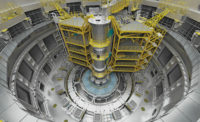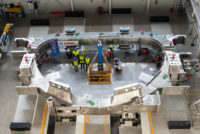

Contractors for the main buildings to house the next generation of nuclear-fusion research are due this month to start receiving final designs, allowing construction to start on the 42-hectare French site this fall. The roughly $410-million contract was signed in December. Now, the main concern for the team delivering the International Thermonuclear Experimental Reactor, or ITER, facility at Cadarache is controlling change orders.
“For us, the challenge is to provide all the contractors with designs on time and manage all the potential changes,” says Laurent Schmieder, project manager with Fusion for Energy (F4E). F4E is the European Union's company procuring the estimated $1.4-billion facility at Cadarache, north of Marseilles, on behalf of the multinational ITER Organisation.
The 66-month contract secured by a Paris-based, VINCI Group-led consortium covers the reactor complex plus nine auxiliary buildings. The consortium includes Spain's Ferrovial Agroman S.A., Madrid, and France's Razel-Bec S.A.S., Christ de Saclay. As work picks up, the site’s labor force is forecast to rise to some 3,000 in the middle of next year from around 200 now.
The consortium's main focus will be the building containing the cylindrical, 28-meter-dia experimental Tokamak reactor, which will rise 29 m though various levels of the building, says a spokesman. Of the contract’s 150,000 cu m of concrete, over 70% will go into the Tokamak building, including some 60,000 cast-in-place elements.
With scientists and specialist engineers around the globe developing their own detailed requirements for the highly technical, experimental facility, ITER's schedule already has slipped up to six months since the program started two and half years ago, adds Schmieder. To manage future modifications, F4E has set firm deadlines for each work package. Any design team seeking to break its deadline must make its case directly to ITER's project head, the organization's deputy director-general, Remmelt Haange, explains Schmieder.
Nevertheless, because of the project's evolving nature, F4E has included a contingency of nearly $90 million in the contract budget, adds Schmieder. Also, the concrete work is covered by cost-reimbursable provisions based on previously agreed-upon unit prices. The more certain steelwork element is largely on a fixed-price basis.
As the consortium prepares to receive its first final designs, a roughly 16-m-deep, 80-m-wide, 115-m-long basement pit is waiting. Built under a separate contract, the pit is lined with nearly 500 concrete plinths rising from its 1.5-m-thick base slab. The roughly 1.7-m-tall plinths are each topped with elastomeric bearings to isolate the reactor building from future seismic movements.
Starting work in April 2010, Engage S.A. is F4E's architect-engineer for the entire ITER complex of 39 buildings and its infrastructure. Engage includes WS Atkins plc, London; Spain’s Empresarios Agrupados S.A., Madrid; and the Paris-based French firms Assystem S.A. and Iosis/Egis S.A.
ITER's main buildings are due for phased completion from 2015, allowing mechanical and electrical speciality contractors to do their work. The contract is due for final handover in 2018; fusion research will follow later, around 2020.
During some two decades of subsequent research, ITER will aim to increase the scale of fusion power generation to 500 MW from the 20 MW achieved in earlier work in the U.K. If all goes according to plan, the next phase would be a demonstration reactor in Japan. The estimated $20-billion research effort in France is roughly 50% funded by the EU, with China, Russia, South Korea, India and the U.S. providing the balance.






